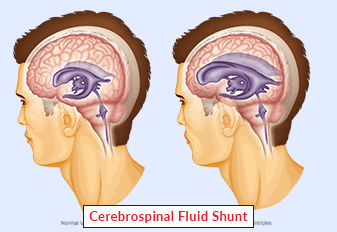Cerebrospinal Fluid Shunt (CFS) Treatment

Cerebrospinal fluid (CSF) shunt treatment is a surgical procedure used to treat hydrocephalus, a condition in which there is an excessive accumulation of CSF in the brain. India has many hospitals and medical centers that offer CSF shunt treatment.
The procedure involves the placement of a shunt system to divert excess CSF from the brain to another part of the body where it can be absorbed. The shunt system consists of a catheter that is inserted into the brain's ventricles and a valve that regulates the flow of CSF.
Book an AppointmentAbout Cerebrospinal Fluid Shunt
A frequent medical technique that can often save the lives of patients with hydrocephalus is the implantation of cerebral spinal fluid (CSF) shunt systems. Through the use of shunt mechanisms, extra fluid from the brain is sent to another area of the body where it is absorbed as part of the circulatory system. Three primary parts make up CSF shunts: an in-flow tube (catheter), a valve that controls the fluid flow, and an out-flow catheter that transports fluid to the heart or belly where it can be absorbed.
One advantage of CSF shunt treatment in India is that it is a cost-effective option for patients who may not be able to afford the same treatment in other countries. India has a large network of hospitals and clinics that offer CSF shunt treatment at an affordable cost, making it accessible to a wider population.
Procedure of Cerebrospinal Fluid Shunt
A cerebrospinal fluid (CSF) shunt is a medical device that is surgically implanted in the brain to help drain excess cerebrospinal fluid that may build up due to conditions such as hydrocephalus. Here's an overview of the CSF shunt treatment procedure:
-
Preoperative evaluation: The patient will undergo various tests, including neurological examination, imaging tests such as MRI or CT scan, and possibly a lumbar puncture to assess the level of CSF.
-
Anesthesia: The patient will be given anesthesia to ensure they are comfortable and pain-free throughout the procedure.
-
Surgery: A neurosurgeon will make an incision in the scalp and drill a small hole in the skull. The shunt device will then be inserted into the brain and positioned to allow for the drainage of CSF. A catheter will be threaded under the skin to a location where the excess fluid can be drained and absorbed by the body.
-
Closing the incision: The surgeon will then close the incision in the scalp using sutures or staples, and the patient will be moved to a recovery area.
-
Postoperative care: After surgery, the patient will be monitored closely for any signs of complications such as infection or bleeding. They may also receive antibiotics or pain medication as needed. The patient will need to rest and avoid strenuous activity for several weeks after the procedure.
-
Follow-up: The patient will need to follow up with their doctor for regular monitoring and adjustments to the shunt as needed.
Require Assistance?
Get A Quick Callback From Our Healthcare Experts






